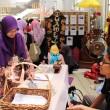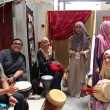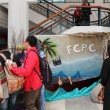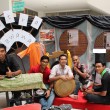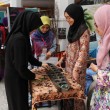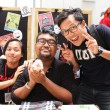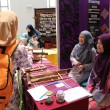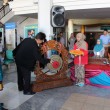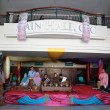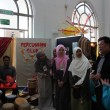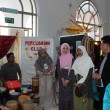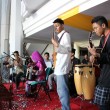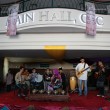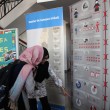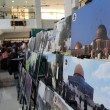Photo caption: One of the participants giving ‘bunga telur’ to Dr. Mahadi while visiting the exhibtion.
By Hamka Rosli
GOMBAK, 10 February 2015: Centre for International Islamic Culture (CiTRA) has recently organised an exhibition at Foyer 1, Cultural and Arts Centre (CAC). The exhibition was aimed at promoting all the fourteen clubs under CiTRA that can be categorised into: performance arts based club, musical club and dancing club.
Students could fill up some enjoyment by looking at the booths that was open from 10 a.m until 6.30 pm. The exhibition was to show the uniqueness of Malay culture in musical, dancing and performing arts to IIUM community.
There were busking shows too performed by Nasyeed Club, Andeka Caklempong Club and Nafastari, the Malay traditional dancing Club. The crowd which consisted mostly of IIUM students had really enjoyed the performance.
œI really love to watch performances which are unique and still uphold the tradition of our ancestor, said Najwa Akmal, a student from Kulliyah of Economics and Management Sciences (KENMS), during the busking performance.
The valuable part of this exhibition is that it unites the students from various Kulliyyahs in IIUM just to make a showcase about the Malay culture, at the same time to make people be aware there are still youths who want to brace the solitary of its own culture. œThis exhibition is not only to promote the clubs but also to strengthen the bonding between each club, said Nur Qalilah, athird year student and one of the committee members of the exhibition.
œI can see that all members from various clubs started to mix around and generate the ukhuwwah despite the differences, she added.
The best part of the showcase is when visitors or students could play with the traditional musical instruments placed at the booths.
The Director CiTRA, Dr. Mahadi J Murat was there too to give his support to the students. He said it is necessary to hold this exhibition for Citra, as a new division, to explain and inform the IIUM community what CiTRA is exactly does, at the same time to identify the sentiment of our culture.
œWe also want those who are involved to be recognised by the community through cultural performance, he added.
Mahadi really hoped for the show case to receive full support from the community because the idea came from the students themselves.***




